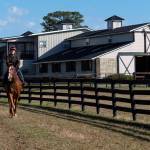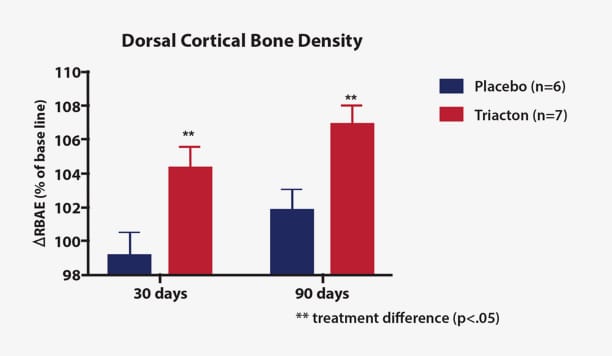Kentucky Equine Research Study Benefits Bone Density

Recent work completed at Kentucky Equine Research will benefit growing horses and racehorses in two important ways: bone density and gastric health.
The research involves calcium absorption, bone mineralization, and acid buffering in the gastrointestinal tract, and will have significant applications for two main groups of horses—mares and foals, where sound growth and development begins, and young athletic horses in pre-training and racing, where soundness is paramount. The secondary benefit, a pH-buffering effect in both the stomach and hindgut, has important implications for improved gastrointestinal health in all horses, particularly those on high-grain diets.
All growing horses require energy, protein, vitamins, and minerals. The most critical minerals for sound growth of young horses are the macrominerals calcium and phosphorus and the microminerals copper and zinc. One of the biggest challenges in producing sound horses is avoiding developmental orthopedic disease (DOD), or growth disturbances resulting from abnormal bone development, such as physitis and osteochondritis dissecans (OCD). Researchers have identified that horses with lower bone mineral density sometimes have more severe OCD scores, possibly related to the link between bone tissue strength and bone density (Firth et al., 1999). Whilst DOD is considered multifactorial, nutrition imbalances are a potential risk factor.
A more bioavailable source of nutrients critical to bone-building is, therefore, a significant advantage. When assessing mineral transfer from mare to foal, milk is the main source of calcium and phosphorus during early life, whilst minerals such as copper and zinc are passed on during pregnancy, being stored in the liver of the fetus in the final months of gestation.
Skeletal issues in young growing horses and racing horses are major performance, welfare, and ethical issues around the globe. Researchers use bone density as a key indicator of bone strength. Low bone density is associated with a higher incidence of skeletal problems such as fractures, shin soreness, OCD, and sesamoid issues (Nielson et al., 1997; Kobayashi et al., 2007). This is of particular significance in young horses, which at birth have a bone density of about 17%. This increases to about 74% at a year of age. Furthermore, bone is continually remodeling and adapting to periods of exercise and rest until horses reach skeletal maturity at the age of five to six years. During this period, racehorses are put through the rigors of sale preparation, training, and racing to begin their careers, so increased bone strength is pivotal in minimizing the risk of skeletal problems, with the most common being equine dorsal metacarpal disease, also known as shin-soreness.
Calcium makes up about 35% of bone structure, with approximately 99% of the calcium in the body found in the bones and teeth. With this in mind, researchers at Kentucky Equine Research wanted to test the bioavailability of various calcium sources. They compared traditional sources of calcium, such as limestone, with a marine-derived source, KER Buffered Mineral Complex (KER BMC™), and found that KER BMC had significantly higher digestibility.
KER BMC has a unique honeycomb structure, with a high surface area to volume ratio, which contributes to the high bioavailability and effective buffering properties for gastric and hindgut pH. Along with this organic calcium source, bioavailable sources of organic copper, manganese, and zinc are included to ensure high digestibility of other bone-building nutrients.
To test the efficacy of this blend for improving bone density in Thoroughbred racehorses in active training, Kentucky Equine Research conducted a research trial in thirteen two- and three-year-old horses in training in Florida for a period of 90 days. Horses consisted of two-and three-year-olds that were beginning race training, three-year-olds in active race training, and older horses returning to training after a 60- to 90-day break from active training. Horses were fed timothy hay and a fortified concentrate at levels required to maintain body weight throughout the study. The base diet supplied 64 g calcium and 42 g phosphorus per day. Seven horses received 120 g/d of KER Triacton®, which supplied an additional 15 g calcium and 3 g phosphorus, and seven horses received 120 g/day of a placebo pellet. The supplement contained calcium, phosphorus, magnesium, silicon, boron, copper, zinc, manganese, and vitamins A, D, K and C. The horses were paired by age and exercise intensity and then randomly assigned to treatments. One horse from the placebo group was removed from the study because of lameness unrelated to bone development and has not been included in study results. There was no difference in average age between the two groups. Training consisted of slow and fast work. The average total distance trained by the horses at different gaits in each treatment group was measured using KER ClockIt Race, and there was no difference in training intensity or duration between the two treatment groups (Pagan et al., 2018).
Radiographs of the left front cannon bone from dorsal-palmar and lateral-medial views were taken at 0, 30, 60, and 90 days of the study. An aluminum step-wedge was placed in plane with the cannon bone to use as an external measure of bone density. The density of the lateral, medial, dorsal, and palmar cortexes of the cannon bone were measured.

Dorsal cannon bone density in Thoroughbred racehorses.
The study showed that the horses fed KER Triacton had a significant increase in both dorsal cortical and palmar cortical bone density compared to the placebo group, which was unchanged in 90 days. The results were pivotal, and confirmed the hypothesis that the increased bioavailability of these key bone-building minerals sources when combined with important vitamins, would have a significant impact on the quality of bone and bone formation, as demonstrated through significantly increased bone density and a trend to increased bone thickness and width. As bone density is a key indicator of bone strength, researchers concluded that supplementation with Triacton resulted in stronger bones.
This bone-building supplement will be a great tool for breeding farms, suiting mares in foal, foals, weanlings, and yearlings. These developments will also benefit horses spelling on farm, as researchers know that bone density decreases during rest periods (Kobayashi et al., 2007), and also those beginning pre-training, as bone remodeling occurs as horses adapt from rest to exercise.
Further studies at Kentucky Equine Research showed the KER BMC served as a potent buffer in the gastrointestinal tract. Reducing acid load in both gastric and hindgut regions of the digestive tract is important to maintain health. Whilst traditional limestone (calcium carbonate), commonly used as a source of calcium in feeds, has some ability to buffer acid, KER BMC provided greater buffering capacity throughout the digestive tract.
Excessive acidity in the stomach is a primary factor in the development of gastric ulcers in horses. The problem is prevalent in racing horses, where up to 90% suffer from gastric ulceration during their careers. Laboratory studies at Kentucky Equine Research showed that KER BMC increases buffering capacity 2.7‐fold in acid conditions typically seen in the stomach. In vivo studies further confirmed the buffering capacity of KER BMC, as horses fed sweet feed with KER BMC had greater gastric fluid pH one hour post feeding (6.2 vs 2.0) than those fed sweet feed alone. When pH is below 4, there is an increased risk of ulcer development.
Further down the digestive tract, excessive acid production in the large intestine can lead to hindgut acidosis. Hindgut acidosis often occurs in horses with high grain intakes or in horses grazing rich pasture. Symptoms of hindgut acidosis include poor appetite, loose manure, chronic colic, and stereotypic behaviours such as wood‐chewing and stall‐walking. Acute hindgut acidosis can lead to intestinal damage and even laminitis. The subsequent research at Kentucky Equine Research showed that a diet including KER BMC improved hindgut buffering capacity by 54% compared to the same diet without KER BMC supplementation. The buffering properties in both regions of the gastrointestinal tract will be of benefit to all horses, especially during stressful periods such as weaning, yearling preparation, and racing.
These multidimensional results could be pivotal in protecting the skeletal health of racehorses. Globally, leading feed companies in the US and UK have embraced the research by moving to include the active components in manufactured feed products, as well as offering availability as a standalone product, KER Triacton. Astute breeders and trainers are opting to utilize the research by incorporating Triacton into their feeding practices via Milne Feeds. Through its global community of Brand Alliance Partners, Kentucky Equine Research is committed to making the latest nutrition research and innovation accessible for horse people in all areas, including right here in Western Australia.
References
Firth, E.C., P.R. Van Weeren, D.U. Pfeiffer, J. Delahunt, and A. Barneveldt. 1999. Effect of age, exercise and growth rate on bone mineral density (BMD) in third carpal bone and distal radius of Dutch Warmblood foals with osteochondrosis. Equine Veterinary Journal Suppl. 31:74-78.
Kobayashi, M., K. Ando, M. Kaneko, Y. Inoue, Y. Asai, and H. Taniyana. 2007. Clinical usefulness of the measurement of bone mineral content by radiographic absorptiometry in the young Thoroughbred. Journal Equine Science 18:99-106.
Nielsen, B.D., G.D. Potter, E.L. Morris, T.W. Odom, D.M. Senor, J.A. Reynolds, W.B. Smith, and M.T. Martin. 1997. Changes in the third metacarpal bone and frequency of bone injuries in young Quarter Horses during race training: Observations and theoretical considerations. Journal Equine Veterinary Science 17:541-549.
Pagan, J.D., A. Swanhall, E. Ford, E. Mulvey, and P.J. Huntington. 2018. Mineral and vitamin supplementation including marine derived calcium increases bone density in Thoroughbreds.
In: Proc. Australian Equine Science Symposium 7. In press.








